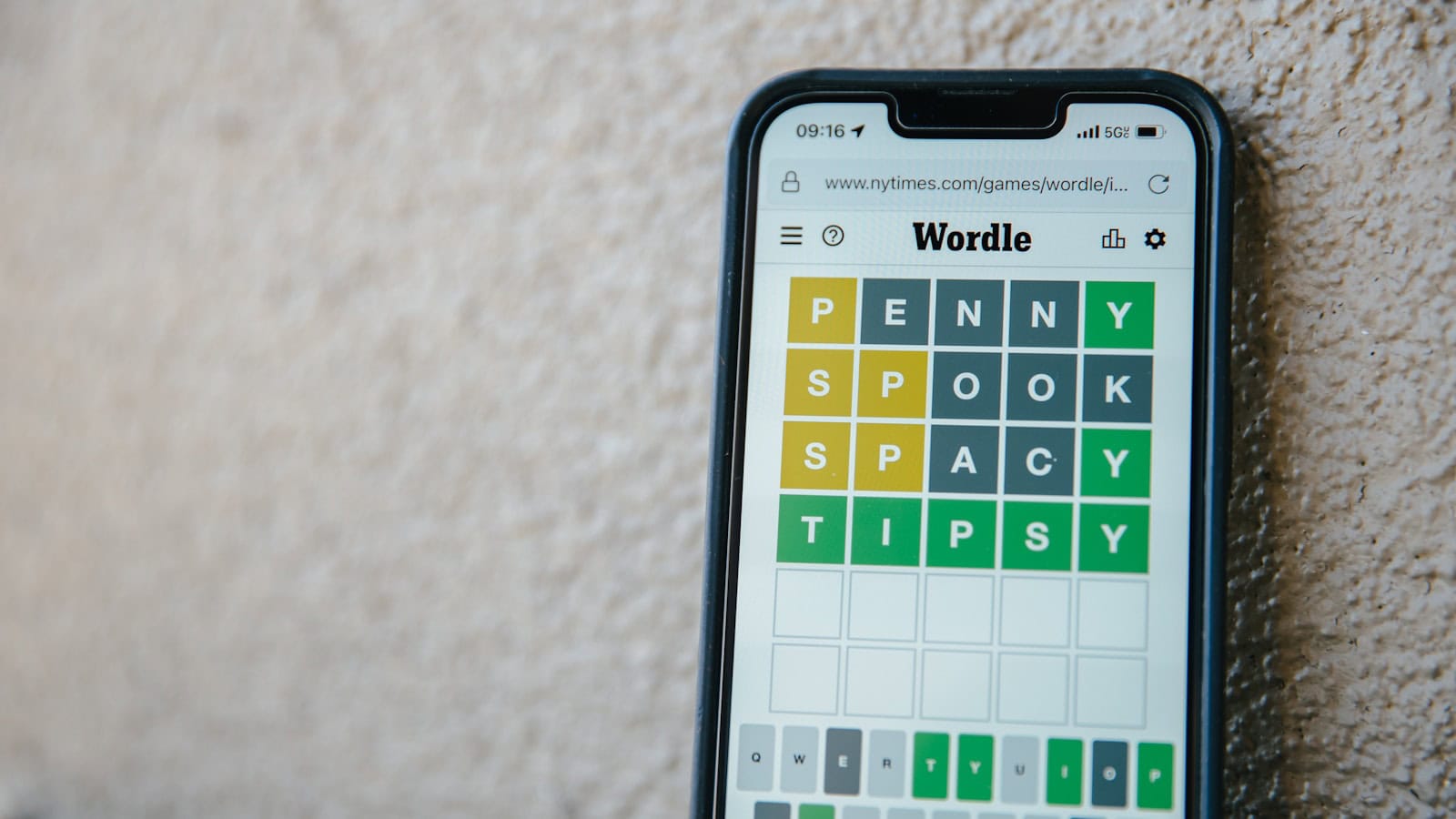Wordle has become a daily ritual for word game enthusiasts around the world. This simple yet addictive game gives players six attempts to guess a five-letter word, with color-coded feedback after each guess. Players have six tries to figure out the day’s secret five-letter word, with yellow squares indicating correct letters in wrong positions and green squares showing correct letters in correct positions.
Getting started is easy. Just open the Wordle website or app and type your first five-letter word guess. The game will highlight letters that are in the correct position with green, show letters that are in the word but in the wrong position with yellow, and gray out letters that aren’t in the word at all. This feedback helps narrow down possibilities with each new guess.
Many players develop their own strategies, from starting with vowel-heavy words to using common consonant combinations. Some prefer to use the same starting word every day, while others mix it up based on their mood. The beauty of Wordle lies in its simplicity and the satisfying challenge of solving the puzzle in as few guesses as possible.

How to Play Wordle: A Simple Guide
Wordle is a daily word puzzle game that challenges players to guess a five-letter word in six tries or fewer. It’s simple to play but deeply satisfying, especially when you solve the puzzle with just a few guesses.
Here’s how it works:
🎯 Objective
Guess the secret 5-letter word within six attempts.
🕹️ How to Play
- Enter a 5-letter word into the game’s input field.
- Press “Enter” to submit your guess.
- The game provides color-coded feedback for each letter:
- 🟩 Green: Correct letter, correct position.
- 🟨 Yellow: Correct letter, wrong position.
- ⬜️ Gray: Letter is not in the word at all.
📘 Example
Let’s say the secret word is PLANT, and your first guess is TRAIL.
| Letter | Feedback |
|---|---|
| T | 🟨 Yellow (in word, wrong place) |
| R | ⬜️ Gray (not in word) |
| A | 🟩 Green (correct place) |
| I | ⬜️ Gray (not in word) |
| L | 🟨 Yellow (in word, wrong place) |
Based on this, you know:
- A is in the correct spot (3rd letter),
- T and L are in the word but need repositioning,
- R and I are not in the word at all.
🧠 Strategy Tips
- Start with a good first word that has common vowels and consonants (e.g., CRANE, SLATE, AUDIO).
- Use process of elimination. If a letter turns gray, avoid reusing it unless necessary.
- Reposition yellow letters until you find their correct spot.
- Don’t waste guesses—every word should give you new information.
📆 New Puzzle Every Day
Wordle refreshes daily with a new word, so players worldwide are solving the same puzzle each day. It’s quick, usually taking 5–10 minutes to play.
🔒 Bonus: Hard Mode
If you’re up for a challenge, turn on Hard Mode in the settings. It forces you to use revealed hints in your following guesses—no skipping useful info!
Wordle is free to play and available on The New York Times website, with no app download needed. Happy guessing!
Key Takeaways
- Wordle gives players six attempts to guess a five-letter word with color-coded feedback after each guess.
- Starting with vowel-heavy words or words with common letters like S, T, R, and E can improve your chances of success.
- The game resets daily with a new word, making it a perfect quick mental exercise for word lovers.
The Basics of Wordle
Wordle is a simple yet addictive word game that challenges players to find a five-letter word in six attempts. The game provides feedback after each guess to help narrow down the solution.
Understanding the Game Objective
Wordle presents players with a daily challenge to discover a single five-letter word. Unlike many word games, Wordle offers just one puzzle per day, making each attempt special.
The main goal is to guess the secret word in as few attempts as possible. Players have a maximum of six tries to figure out the answer. This limited number of attempts adds excitement and strategy to the game.
Success in Wordle depends on your vocabulary knowledge and ability to use the clues from previous guesses. The game is designed to be challenging but accessible to most players with basic English vocabulary.
The Rules of Wordle
Each guess must be a valid five-letter word. Random letter combinations or made-up words aren’t accepted by the game. After submitting a guess, the tiles change color to provide feedback:
- Green tiles indicate correct letters in the correct position
- Yellow tiles show correct letters in the wrong position
- Gray tiles represent letters not in the word at all
Players must use this color-coded feedback to refine subsequent guesses. The game doesn’t repeat clues – each guess provides new information to help solve the puzzle.
All six guesses need to be completed in a single session as the game doesn’t save progress. A new Wordle becomes available each day at midnight.
Interface and Controls
Wordle’s interface is clean and straightforward. The game displays a grid with six rows of five squares each. Each row represents one guess attempt, and each square holds one letter.
To play, simply type a five-letter word using your keyboard. Press “Enter” to submit your guess. The on-screen keyboard also changes colors to help track which letters you’ve already tried.
Players can use the Backspace key to delete letters before submitting a guess. The game automatically progresses to the next row after each submission.
Wordle includes a share feature that allows players to copy their results as a pattern of colored squares to share on social media without spoiling the answer for others.
Strategies for Beginning Wordle
The first few moves in Wordle can make or break your game. Having a solid strategy from the start helps you uncover letters efficiently and narrow down possibilities quickly.
Choosing Your Starting Word
Starting with a word that contains common letters gives you the best chance of finding matches early. Words with multiple vowels are particularly helpful since most English words contain at least one vowel.
Popular starting words include:
- STARE – contains common letters S, T, A, R, E
- ADIEU – tests three vowels at once
- ROATE – good mix of common consonants and vowels
- CRANE – balanced with common letters
Some players prefer words like EARTH or STAIR that have common letters and multiple vowels. Others follow a three-word strategy using words like SCALY, GUIDE, and THORN to test a wide range of letters quickly.
Choose a consistent starting word to help you develop pattern recognition over time.
Analyzing Letter Positions
Pay close attention to the color feedback after each guess:
🟩 Green: Right letter, right position
🟨 Yellow: Right letter, wrong position
⬛ Gray: Letter not in the word
When you get a yellow letter, try it in different positions in your next guess. For green letters, keep them in the same spot for all future guesses.
Create a mental map of where letters can and cannot appear. If “R” shows yellow in position 2, you know it’s in the word but not in that spot.
Track which letters you’ve tested and which remain unknown. This helps prevent wasting guesses on letters you’ve already ruled out.
Effective Guessing Techniques
After your first guess, adapt your strategy based on the feedback. If you get multiple yellow or green letters, focus your next guess on repositioning yellows while keeping greens fixed.
Consider these techniques:
- Process of elimination: Use early guesses to rule out common letters
- Letter frequency: Prioritize common letters (E, A, R, I, O, T, N, S, L)
- Word patterns: Look for common endings (-ING, -ED, -ER)
Don’t repeat letters in early guesses unless necessary. Each unique letter gives you new information.
If your first two guesses yield few matches, consider a completely different word to test new letters. This “information gathering” approach often works better than immediately trying to solve the puzzle.
Advanced Wordle Techniques
Once you’ve mastered the basics of Wordle, it’s time to level up your game. Advanced techniques can help you solve puzzles more efficiently and increase your success rate, especially with challenging words.
Utilizing Game Statistics
Tracking your Wordle statistics provides valuable insights into your playing patterns. The game keeps track of your win percentage, current streak, and maximum streak.
Pay attention to your guess distribution chart. If you notice you rarely solve puzzles in three guesses but often need five or six, you might need to refine your strategy.
Many Wordle enthusiasts use spreadsheets or notes to record their daily words and guesses. This practice helps identify patterns in both the game and your approach.
Some players even analyze which starting words yield the best results over time. Testing different openers across multiple games can reveal which ones consistently give you more green and yellow tiles early.
Letter Frequency and Word Patterns
Understanding letter frequency in English can dramatically improve your Wordle performance. The most common letters are E, A, R, I, O, T, N, S, L, and C.
Starting with words that contain high-frequency letters helps eliminate possibilities quickly. Words like “STARE,” “ROATE,” or “SLATE” are popular choices among experts.
Consider using a two-word opening strategy to cover more letters. For example:
- First guess: “STARE” (covers S, T, A, R, E)
- Second guess: “Colin” (covers C, O, L, I, N)
This approach helps you identify 10 different letters by your second guess.
Watch for common word patterns too. English has predictable letter combinations like “TH,” “CH,” “ING,” and “ED” that appear frequently in five-letter words.
Managing Hard Mode
Hard Mode requires you to use previously revealed hints in subsequent guesses. This creates both challenges and opportunities for strategic players.
In Hard Mode, prioritize placing confirmed letters (green tiles) in different positions to test multiple word structures. For example, if “A” is confirmed but its position isn’t, try words with “A” in different spots.
Be cautious about committing to green letters too early. Sometimes it’s better to use a guess to eliminate multiple letter possibilities rather than focusing solely on placing confirmed letters.
When faced with multiple possible solutions (like BATCH, MATCH, CATCH), use strategic guesses that could eliminate several options at once rather than guessing each possibility individually.
Keep a mental library of uncommon letter pairings that might appear, such as “QU,” “PH,” or “GH.” These can be particularly challenging in Hard Mode where your options become increasingly limited.
Common Pitfalls and How to Avoid Them
Even the best Wordle players make mistakes. Understanding these common errors and learning strategies to overcome them can significantly improve your game and help you solve puzzles more efficiently.
Overcoming Incorrect Assumptions
Players often get stuck when they make wrong assumptions about letter positions. When a yellow letter appears, many players continue placing it in the same spots in subsequent guesses, wasting valuable attempts.
Instead, try systematically testing different positions for yellow letters. Keep track of where you’ve already placed them to avoid repetition.
Another common mistake is assuming certain letter patterns don’t exist. Remember that Wordle includes uncommon letter combinations and word structures that might seem unusual.
Use a methodical approach by eliminating impossible positions for each letter. Create a simple grid on paper or mentally track which letters can go where based on previous feedback.
Don’t get fixated on a particular word. If you’re stuck, consider completely different word structures that could fit your confirmed letters.
Avoiding Repeated Mistakes
Many players fall into predictable patterns that hurt their game. One major mistake is using too many vowels in early guesses. While vowels are important, consonants often provide more useful information.
Balanced Opening Strategies:
- Use words with common letters (R, S, T, L, N, E)
- Include a mix of vowels and consonants
- Avoid duplicate letters in early guesses
Another error is ignoring the gray letters. These eliminated letters provide valuable information by narrowing down possibilities. Keep track of them!
Players sometimes forget previous game lessons. Create a personal “strategy note” with approaches that have worked well for you in past games.
Avoid rushing through guesses when frustrated. Taking a short break can help your brain process information differently and see new patterns.
Dealing with Consecutive Losses
Losing streaks can be discouraging, but they provide valuable learning opportunities. Analyze what went wrong in previous games instead of getting frustrated.
When facing multiple losses, many players begin making desperate guesses. Resist this urge and return to methodical play with a calm approach.
Try changing your starting word after several losses. Your usual opener might not be as versatile as you think.
Recovery Strategies:
- Review your overall approach objectively
- Focus on information gathering in early guesses
- Consider using elimination strategy words
Remember that Wordle has an element of luck. Some words are simply harder to guess due to uncommon letters or multiple possible combinations.
If you’re truly stuck, it’s okay to lose one game to protect your mental approach to future games. Learn from the loss and move forward with new insights.
Daily Practice and Improvement
Consistent practice is key to mastering Wordle. Players who dedicate time to regular play and track their results often see significant improvement in their solving abilities.
Setting Up a Practice Routine
Creating a daily Wordle habit helps build word pattern recognition skills. Many successful players solve the official New York Times Wordle each morning as part of their daily routine.
For additional practice, players can use archive sites or Wordle clones that offer unlimited plays. Setting aside just 5-10 minutes daily makes a significant difference in skill development.
Some players find it helpful to play at the same time each day when their mind is sharpest. Morning players often report better focus, while evening players may benefit from a more relaxed approach.
Tracking Your Progress
Keeping records of your Wordle attempts provides valuable insight into your improvement. Many players screenshot their results or use the share feature to save their daily scores.
Simple tracking methods include:
- Recording the number of guesses per puzzle
- Noting which starting words lead to faster solutions
- Tracking your success rate with hard mode enabled
Several free apps and websites offer Wordle stat tracking. These tools can generate graphs showing your average number of guesses over time, success rates, and streak information.
Using External Resources and Tools
While purists prefer solving without help, various resources can improve your skills for future games.
Helpful Wordle resources:
- Word frequency lists to learn common five-letter words
- Letter frequency charts showing which letters appear most often
- Practice sites that explain optimal guessing strategies
Some players use “training mode” Wordle variants that provide unlimited daily practice with feedback on word selection strategy. Word knowledge books and vocabulary-building exercises also contribute to long-term improvement.
Dictionary apps can help expand your five-letter word vocabulary between games, focusing particularly on words with common letter patterns.
Engaging with the Wordle Community
Wordle isn’t just a solo activity—it’s become a social phenomenon that brings people together. Players around the world share their experiences, strategies, and daily results in various online spaces.
Participating in Online Forums
Reddit hosts several active Wordle communities where players discuss daily puzzles and share tips. The r/wordle subreddit has thousands of members who post their results using the now-familiar colored square emojis.
Twitter became an early hub for Wordle enthusiasm when players began sharing their results using the colored square pattern. The #Wordle hashtag lets you connect with fellow players and see how others are performing.
Discord servers dedicated to word games provide real-time chat about Wordle strategies. Many offer separate channels for puzzle discussion, avoiding spoilers for those who haven’t played yet.
Facebook groups bring together players of all skill levels. These communities often welcome beginners and provide a supportive environment for learning the game.
Competing with Friends and Family
Wordle’s simple sharing feature makes it easy to compare results. The colored grid pattern shows your path to solving without revealing the actual word, perfect for friendly competition.
Many families establish Wordle routines, discussing the day’s puzzle over breakfast or in group chats. This creates a daily touchpoint and friendly rivalry.
Some friend groups track “streaks” and success rates over time. Creating a simple leaderboard in a shared document or group chat can add motivation to maintain your daily Wordle habit.
Work colleagues often use Wordle as a quick bonding activity, comparing results during breaks. This light competition builds camaraderie without taking too much time from the workday.
Mobile and Web Accessibility
Wordle is available on various platforms with accessibility features for all players. Recent updates have made the game more inclusive for those using screen readers and other assistive technologies.
Playing Wordle on Different Devices
Wordle is primarily web-based, meaning it can be played on almost any device with a browser. Players can access the game on desktops, laptops, tablets, and smartphones. On iOS devices, VoiceOver compatibility has been added, allowing visually impaired users to enjoy the game.
To play Wordle with VoiceOver on an iPhone, users need to enable the feature in their settings. Some players may need to install a browser extension or use a specific bookmarklet to enhance accessibility.
For mobile players, adding Wordle to the home screen creates a convenient shortcut. On iOS, this can be done through the “Add to Home Screen” option in the share menu.
Optimizing Your Play Experience
Several adjustments can improve the Wordle experience for players with different needs. For those using screen readers, the game now provides feedback about letter colors through audio descriptions rather than just visual cues.
Chrome users can install extensions specifically designed to make Wordle more accessible. These tools announce the results of each guess and describe the colored blocks that indicate correct and incorrect letters.
The standard color scheme (green, yellow, and gray) might be difficult for some players with color vision deficiencies. Fortunately, Wordle offers a high-contrast mode that can be enabled through the settings menu.
Playing in a well-lit environment and adjusting screen brightness can reduce eye strain during longer gaming sessions.
Cultural Impact of Wordle
Wordle has become a significant cultural phenomenon since its release. The game’s simple concept of guessing a five-letter word in six attempts has captured the attention of millions worldwide.
The game creates a shared experience as everyone guesses the same word each day. This universality has made Wordle a topic of daily conversation in workplaces, schools, and social gatherings.
On social media, the distinctive green, yellow, and gray square patterns have become instantly recognizable. Players often share their results without revealing the word, creating a unique form of communication.
Wordle serves as a perfect medium for social interaction in our increasingly digital world. It connects people through friendly competition and shared experiences despite physical distance.
The game’s popularity crosses age groups and demographics due to its:
- Simple rules anyone can understand
- Free access
- Quick gameplay (usually under 5 minutes)
- Daily nature that creates routine
During the pandemic, Wordle provided a welcome distraction and sense of normalcy. Many players describe it as “bite-sized fun” that offers a brief mental challenge without becoming overwhelming.
The cultural impact extends to language learning and education. Teachers have incorporated Wordle into classrooms to improve vocabulary and spelling in an engaging way.
Wordle’s influence has spawned numerous variations and adaptations, further cementing its place in modern culture. Its success demonstrates how simple ideas can create meaningful connections in today’s busy digital landscape.
Frequently Asked Questions
Here are answers to common questions about Wordle, the popular word-guessing game that has captured the attention of word lovers worldwide.
What are the basic rules of Wordle?
Wordle challenges players to guess a five-letter word in six attempts. After each guess, colored tiles provide feedback.
Green tiles indicate correct letters in the right position. Yellow tiles show correct letters in the wrong position. Gray tiles represent letters not in the target word.
Players use this feedback to refine their next guess and hopefully solve the puzzle before running out of attempts.
What is the best starting word in Wordle?
There’s no single “best” starting word, but words with common letters like STARE, ADIEU, or CRANE are popular choices.
Words with vowels and frequent consonants (S, T, R, N, L) help identify more letters quickly. Some players prefer using words with non-repeating letters to test more characters with each guess.
The ideal starting word often depends on personal strategy and preference.
How can I play Wordle online for free?
Wordle is available for free on The New York Times website. Players can simply visit the NYT Games section or search for “Wordle” online.
No account is required to play the daily puzzle. The game resets each day with a new word challenge for everyone worldwide.
Mobile users can access Wordle through their phone’s web browser without needing to download an app.
Is there a guide for beginners to learn Wordle?
Yes, several beginner guides exist online. The New York Times offers basic instructions on their help page.
New players should focus on learning the color-coding system and developing a strategy for their guesses. Starting with common letter combinations and using the feedback to narrow down possibilities is recommended.
Practice helps beginners understand patterns in five-letter words and improve their solving skills.
How can I access Wordle on my iPhone?
iPhone users can access Wordle through Safari or any web browser by visiting the New York Times Games website.
For easier access, players can add Wordle to their home screen by tapping the share button and selecting “Add to Home Screen.” This creates a shortcut that works similar to an app.
The game functions the same on mobile as it does on desktop computers.
What steps are involved in playing Wordle on a PC?
Open any web browser on a PC and navigate to the New York Times Games section or search for “Wordle.”
Type a five-letter word and press Enter to submit your first guess. Review the colored feedback tiles and use that information to inform your next guess.
Continue this process, refining your word choices based on the feedback, until you either solve the puzzle or use all six attempts.





